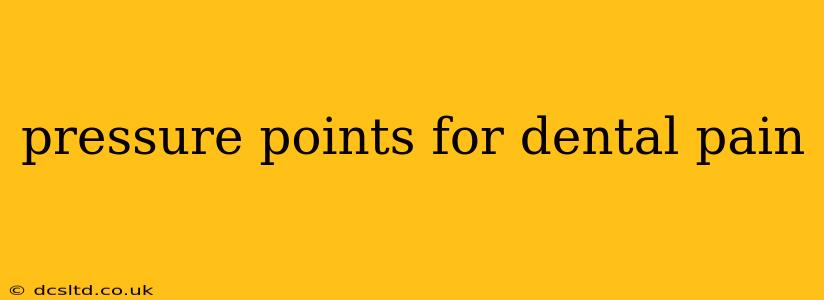Dental pain can be excruciating, often striking at inconvenient times. While professional dental care is crucial for addressing the underlying cause, many people seek immediate relief using alternative methods. Pressure point therapy, an ancient technique rooted in traditional medicine, has gained popularity as a potential method for managing pain, including dental pain. This guide explores the potential pressure points that might offer temporary relief, emphasizing that it's not a substitute for professional dental treatment.
What are Pressure Points?
Pressure points, also known as acupressure points, are specific locations on the body believed to correspond to energy pathways (meridians) in traditional Chinese medicine. Applying pressure to these points is thought to influence the flow of energy, potentially alleviating pain and promoting healing. It's important to remember that the scientific evidence supporting acupressure for dental pain is limited, and more research is needed.
Pressure Points Commonly Associated with Dental Pain Relief
While no specific pressure point directly targets dental pain, several points are associated with the head, face, and jaw, and applying pressure to them might provide some temporary relief for some individuals. Remember, the effectiveness varies greatly from person to person.
It is crucial to note: Applying pressure to these points should be gentle. Avoid excessive pressure, which could cause discomfort or injury.
1. LI 4 (Hegu):
This point is located between the thumb and index finger, on the back of the hand. It's often used to alleviate various types of pain, including headaches and facial pain. Applying gentle but firm pressure to LI 4 for several minutes might provide some temporary relief from dental pain.
2. GB 7 (Qubin):
Located behind the ear, just below the bony protrusion, GB 7 is another point associated with headaches and jaw pain. Gently massaging this area might help alleviate some discomfort.
3. ST 6 (Jiumiao):
Situated on the face, just below the cheekbone, in line with the pupil of the eye, ST 6 is sometimes used to address facial pain and tension. Gentle pressure applied to this point may offer minor pain relief for some.
4. TE 17 (Yuzhen):
Found at the base of the skull, just below the occipital bone, TE 17 is a point related to head and neck pain. Applying pressure here may indirectly ease pain stemming from jaw tension related to dental issues.
How to Apply Pressure to These Points
To apply pressure to these points, use your thumb or index finger. Apply firm but gentle pressure, holding for several minutes at a time. You might find it helpful to massage the area gently in a circular motion. Listen to your body and stop if you experience any increased discomfort.
Does Acupressure Actually Work for Dental Pain?
The effectiveness of acupressure for dental pain is not definitively proven through rigorous scientific studies. While some individuals report experiencing temporary relief, others may not find it helpful. It’s crucial to remember that acupressure is not a replacement for professional dental care.
What are the Limitations of Acupressure for Dental Pain?
- Not a Cure: Acupressure, at best, offers temporary pain relief and does not address the underlying cause of the dental problem.
- Individual Variation: Its effectiveness varies significantly among individuals. What works for one person might not work for another.
- Not a Substitute for Professional Care: It's crucial to seek professional dental treatment for diagnosis and treatment of dental pain.
When to See a Dentist
If you are experiencing dental pain, it is essential to schedule an appointment with a dentist as soon as possible. Delaying treatment can lead to more serious complications. Only a dentist can accurately diagnose and treat the underlying cause of your dental pain. Pressure points might provide temporary comfort, but they should never replace professional dental care.
Conclusion
While pressure point therapy may offer some individuals temporary relief from dental pain, it's vital to remember its limitations. It is not a replacement for professional dental care and should be considered a complementary therapy at best. Always consult a dentist to address the root cause of your dental pain and ensure appropriate treatment.
